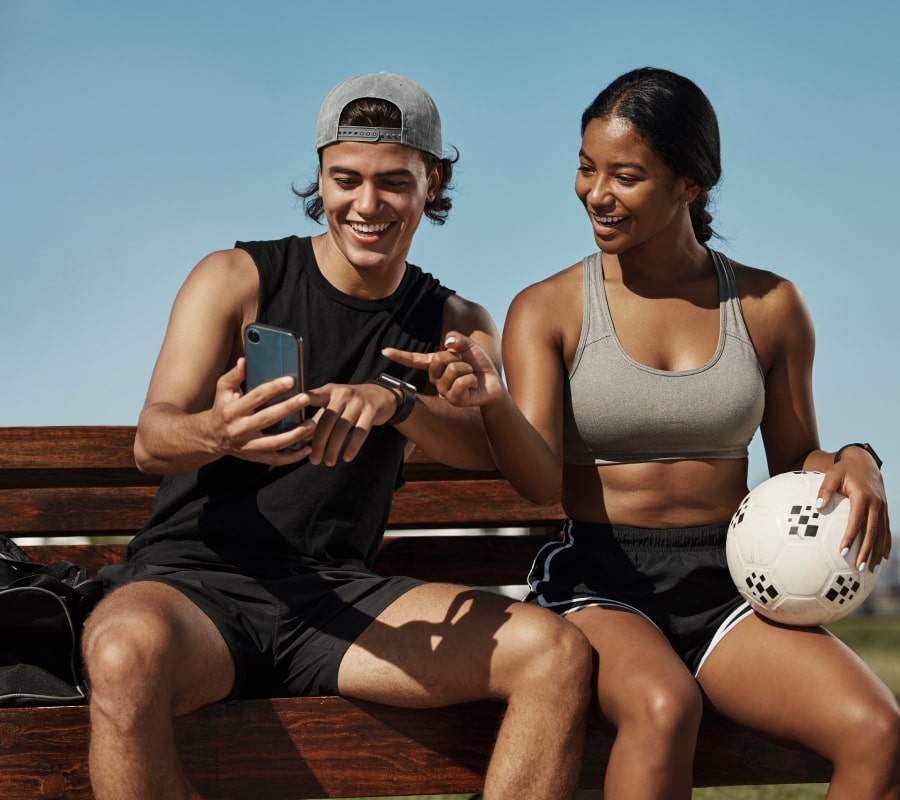Are You Earning Up to Your Potential?
Most personal trainers are undervaluing their time and skills. Our Personal trainer Revenue Calculator helps you find out what you should be making, and how to get there.
No guesswork. Just real numbers.
.jpg)
Personal trainers and fitness professionals are increasingly relying on web-based lead generation to expand their fitness businesses in this increasingly digital environment.
While referrals and word-of-mouth leads are still relevant and valuable, online leads have become an essential component of a successful fitness marketing approach.
The most common online platform is inevitably social media, simply because it’s free for everyone! Not only does social media provide a platform to market one’s personal training services, it also helps in building the brand identity and interacting with users first hand.
TThe next online platform to help with brand visibility and sales is having your own fitness website. It acts as your brand’s digital storefront—showcasing who you are, your programs, and your expertise. With tools like fitness studio software or software for fitness trainers, you can connect your website directly with your services, automate bookings, and make it easy for clients to purchase your fitness plans with just one click.
But is having a website enough for lead generation? No.
Visitors are not going to convert into leads if they don’t find value and leads are not going to convert into clients until you give them a motive.
5 Ways To Make Your Fitness Website More Effective
1. Use High-resolution Photos and Videos
A strong user experience is critical to keep a visitor on your website for longer and to ensure they browse through different pages on the website.
Visuals play a significant role in impression formation. A cover image of you running, for example, will immediately elicit energy, while a cover image of you performing a yoga pose will spark calmness and a different kind of energy.
You need to decide what you want people to perceive and ‘feel’ when they see your website. What zone do you want them to get transported to when they hear about your brand? Play around with that theme, and you’ll be good to go. And, yes, definitely avoid blurry images or ones with watermarks.
In a nutshell, converting a visitor to a potential lead will require high-quality photos and videos that are visually engaging and represent your fitness brand accurately.

💪 Got an idea for a brand? Let's bring it to life.
Launch your own fitness app with FitBudd in minutes!

💪 Got your brand name? Let’s bring it to life.
Launch your own fitness app with FitBudd in minutes!


88% trainers worldwide gave us 5 stars
Transform your fitness business with the power of your branded app on iOS and Android.
Try for FREE2. Write Captivating Headlines
In this highly competitive fitness industry, every personal trainer software or fitness instructor has the same goal - to help clients achieve their fitness goals.
Have you thought then, what makes you unique? What makes your fitness services different? What sets your fitness brand apart from the competition?
Surely, actions speak louder than words, but when it comes to selling your fitness services online, you have to first use the power of words to answer these three questions.
Ensure that your fitness website makes use of smart messaging. For example,
- Catchy headlines so that the visitor notices it in the first place.
- Clear description about yourself, your service, features, benefits, etc., so that everyone can understand the same error-free.
- It will be a good practice to form the content around the most common questions clients ask you, or alternatively, you can have a separate FAQ section as well.
In a nutshell, the point here is to write action-inspiring phrases that compel visitors to stay on the website, get curious about your offerings, and ultimately make a purchase. Don’t discount the power of smart messaging, as it presents a great opportunity to show your uniqueness, brand values, and what you and your brand stand for.

3. Show Your Clients Success Stories
Testimonials play a vital role in marketing, promotion, and sales as they rest on the foundation of trust.
When a potential client sees that other individuals, just like them, have had success with your fitness programs, they are more likely to buy it.
It’s comparable to word-of-mouth marketing, except you're putting it on your website!
Testimonials can be written in a variety of styles:
- Written testimonials
- Transformation a.k.a, before-after photos
- Video testimonials, etc.
Inevitably, the primary motive of testimonials is to show your credibility as a fitness instructor, but testimonials also bring a more human touch to your fitness website.
Looking at real people with real struggles and accomplishments establishes a sense of relativity in the visitor’s mind. Simultaneously, it fosters their motivation: “If they can do it, so can I.”
In a nutshell, testimonials kill two birds with a stone. They increase your fitness brand's trustworthiness and encourage leads to make a purchase.

4. Highlight Your USPs
The three points we discussed so far will assist you in building an attractive fitness brand. You are more likely to acquire the trust of a visitor who lands on your website if you use them.
To convert this curious visitor into a lead or potential client, though, they must be enthralled by your offerings and see the value in them.
If you train people with your own fitness app, for example, a great way to give a 360° view of your services is to highlight key features—like progress tracking, live video calls, or habit coaching. Using tools like gym CRM software helps you showcase these features in one place while automating client management behind the scenes.
So, if your clients like your 21-day fitness challenge, you can prioritize it over other fitness options because it is more likely to sell. If the wearable integration feature or video calling feature is popular with your ongoing clients, you should mention them in the section regarding fitness app features.
In a nutshell, find out what is the most captivating feature of your fitness offerings and use that information to attract more leads.

5. Place Compelling Calls To Action (CTA)
All of your efforts will go in vain if the potential lead does not know what to do next.
CTAs (calls to action) play a pivotal role in conversions and sales.
How? They help you in convincing the lead to take the necessary action, such as purchasing your fitness plan!
But will placing a CTA anywhere on the website do the job? No.
A call to action's effectiveness is determined by two factors: the text (what does your CTA say?) and the placement (where does your CTA appear?)
The text should elicit a response. Using phrases such as 'free,' 'few seats left,' and so on, for example, increases the lead's likelihood of taking advantage of the offer before it's too late.
The position of the CTA is again very important. As a practice, don’t restrict the CTA just at the top and at the bottom of the page. Also, don't use it in every section; otherwise, it will lose its effectiveness. There is no hard and fast rule as to where you should add your call to action, but you can determine the same by analyzing which section of the website talks about what and if adding a call to action at that place helps drive action. If yes, then decide on the language of your call to action.
In a nutshell, make sure to add engaging CTAs (e.g., "Sign Up For Free!" "Get Started," "Join My Team") at strategic locations (e.g., at the top and the end, in the features section, etc.) to support your lead generation efforts.
.png)
Launch Your Personalized Fitness Website With FitBudd For FREE!
If you are a FitBudd Trainer, you must have seen and played around to set up and personalize your FitBudd website. If you are unfamiliar with this, keep on reading.
On launching your fitness app with FitBudd, you also get a customizable fitness website. There are four pages added to this website - Home, About, Plans, and App.
Home Page - This is where you can showcase almost everything that might pique the interest of a potential client. Your fitness mantra, brand value, client testimonials, app features, etc.
About - This is the page where visitors to your website may learn more about you. Use this part to provide all of the information about your fitness business and app that you want potential clients to know.
Plans - This page displays all your active fitness programs and offerings. As soon as you activate a fitness plan on your Trainer Portal, the same will automatically get listed here, and anyone can make a purchase directly from your website.
App - On clicking on this section, the lead will see the QR code and link to download your Fitness App.

3 Quick Ways To Customize Your FitBudd Website
As previously stated, you can directly control the contents of your website through the Trainer Portal that you use to manage other things of your clients.
Once you login to your FitBudd Trainer Portal, on the left menu panel, you will see an option marked as Website. To proceed, simply click on it.
To begin editing your website, click on the Edit button on the top right side of the third panel. As a result, the website editor will open in a new screen.
There is room to experiment with many features, but here are 3 quick features you must know about to customize and personalize your website.
1. Check Website Responsiveness
You can easily preview the changes you make to your website in real-time without having to publish them already.
Most people on the internet now search using their mobile phones or tablets. It means your website must be responsive to all devices.
Responsive web design? What does that mean?
A responsive website is one whose appearance changes automatically to different devices and their screen sizes or orientations. This implies that regardless of whether a visitor uses a laptop, smartphone, tablet, or another device, your website will adjust to their screen size without cropping any design or text.
In simpler words, a responsive website is similar to water. It takes on the shape of the container into which it is poured.
The video below demonstrates how you can preview your website in desktop and mobile dimensions.
How will this information help to customize your website? As we explained above the significance of visuals in customer attraction, the same principle applies here. After previewing, you can decide if you want to add more text in a section or remove it, if the pictures you chose are looking fine or not, etc.
2. Head To Toe Personalization
A small but impactful part of a website, especially for branding purposes, is the header and footer.
See it this way - the header is one of the first things that a visitor notices, as it is the header that tells the visitor about the different pages on the website. It also has the brand’s logo and name, and thus it imprints your fitness brand in the visitor's mind. Many websites, including the one you get by FitBudd, this header or top bar moves as a visitor scrolls down the page. This results in a positive user experience.
The footer, on the other hand, displays vital information such as contact info, privacy policy, etc.
Another general setting that is crucial is the social links - links to your Instagram, YouTube channel, Facebook, or any other platform.
To see how you can make changes to all this discussed here, watch the video below.
3. Decide What Your Clients See
Yet another handy feature that will let you control the flow of your website and what your visitor sees is the ability to enable or disable a particular section of your website.
For each section that you click to edit, in the right panel, adjacent to the name of the section, you will see a toggle button.
Simply switch on or switch off to enable or disable that section from your website. Once disabled, that section will hide automatically and will not be shown to the people visiting your website. You can, of course, enable a section later on.
For Instance, if you don’t want the ‘About’ section to appear on your home page, you can disable the same by switching off the toggle button.
This way, you can choose how much or how little you want your clients to see. Again, there’s no rule of thumb here as to what’s a better approach. Sometimes, clients want to see everything, from testimonials to FAQs, and sometimes having just three sections works the deal.
So keep experimenting to figure out what works best for you!
Try FitBudd For Free
Haven’t tried coaching and managing clients with FitBudd yet?
FitBudd is an all-in-one platform for fitness professionals to coach and manage clients from anywhere. Whether you train in-person clients or online, FitBudd simplifies the entire process from onboarding to progress tracking and updates so that you can save time to focus on other aspects of your fitness business.
Don’t believe us; try it for yourself: Sign Up For Free Trial!
Frequently Asked Questions

Grow Your Fitness Business Using Social Media Guide
Unlock the potential of social media to attract clients and grow your business with our expert tips.
Download Now
Templates
These functional templates have the power to make any fitness trainer's life easier.
Subscribe To
Our Blog

































